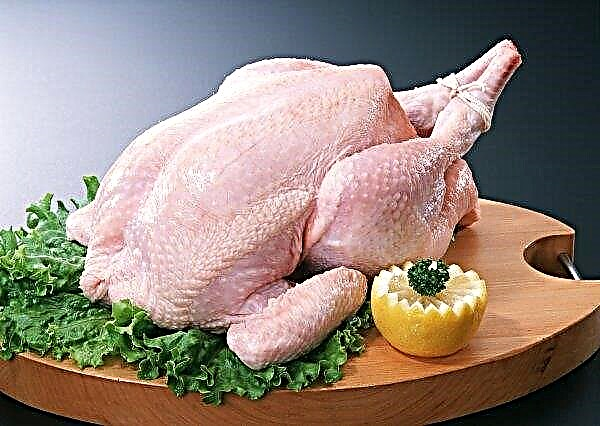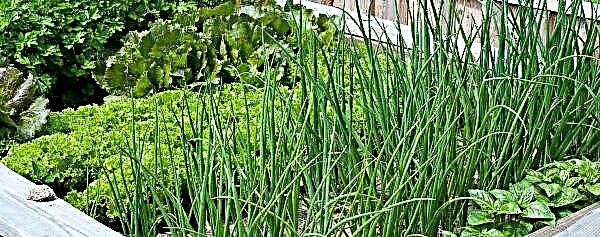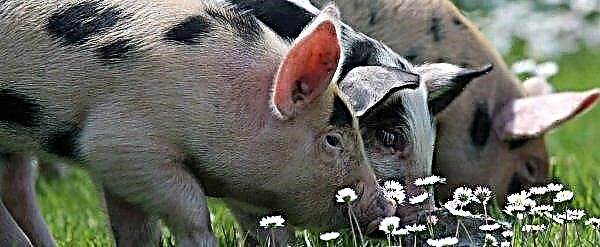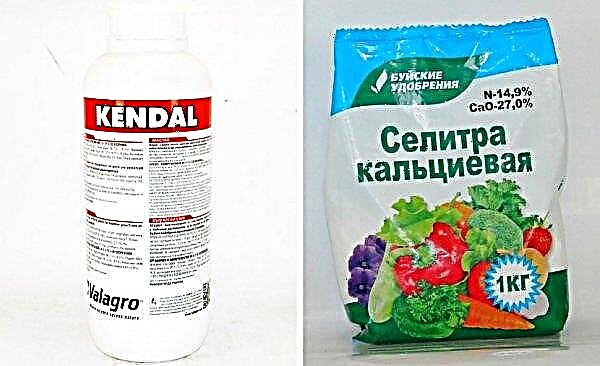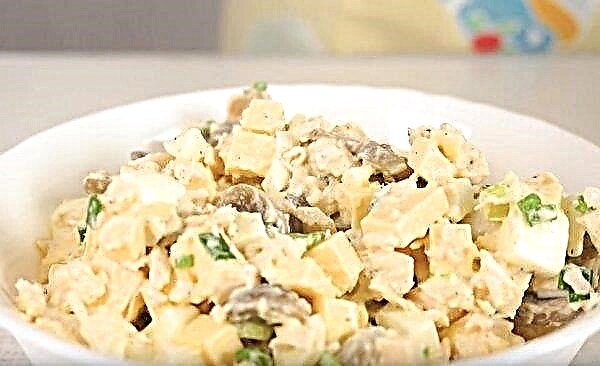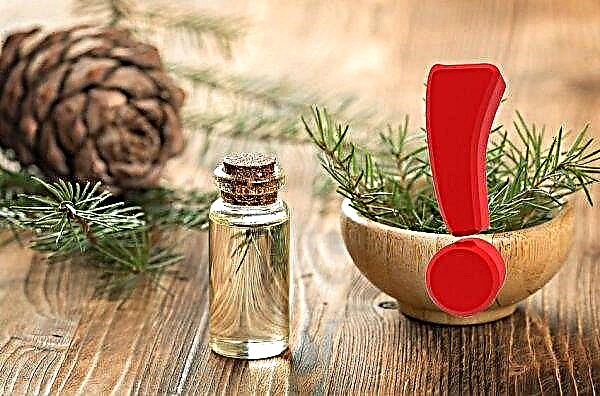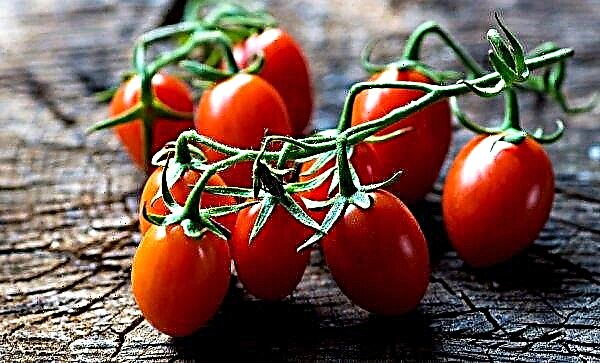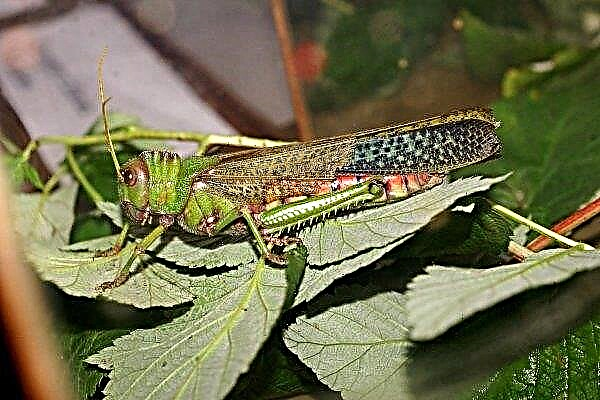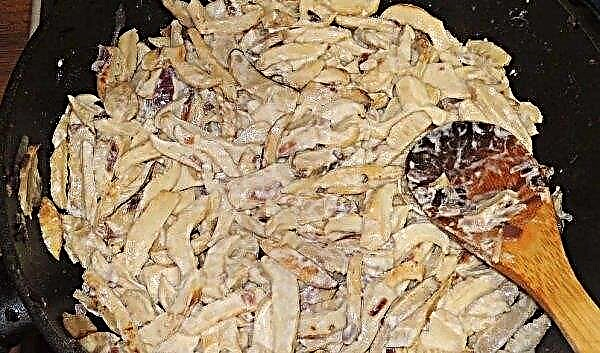Solaris is recognized as one of the best wine grapes - a variety characterized by excellent frost resistance, early ripening, excellent marketability and taste of the fruit. What else are the advantages of the described hybrid and how to grow it in a summer cottage, let's look at the article.
Origin
Solaris is a hybrid variety of industrial grapes of the early vegetative period, which is the result of the crossing of varieties Saperavi northern with Muscat Ottonel. From its genetic basis, the hybrid has received high resistance to frost and disease, as well as high taste qualities of large amber fruits.
The authors of the described variety were German breeders of the state research institute of the city of Freiburg, who were able by crossing two grape varieties to get a new hybrid with excellent agrotechnical indicators.
Solaris is especially popular among winegrowers in the temperate and northern regions of the Russian Federation and European countries, in particular, Germany, Lithuania, Slovakia, and Poland.
Botanical Description
Solaris is an early ripe grape variety, whose growing season is from 105 to 115 days. The first crops can be harvested from late July - early August.
Bushes and shoots
The hybrid belongs to plants with intensive growth rates - the height of its vine in two years can reach 5 m. The bushes are strong-growing, sprawling, quickly shoots and gain green mass. The leaves have a traditional form for all varieties of grapes and a green color. The branches are medium, slightly loose, and lend themselves well to pruning and shaping.
Important! Since the bush is characterized by high growth rates, it requires mandatory pruning and formation, starting from the age of three.
Grapes and berries
The main advantage of the described culture are considered early fruit ripening. The first signs that the grapes have ripened are, firstly, a complete halt to the growth of shoots, and secondly, the staining of the berries in amber color. In this case, the amount of sugar in ripened fruits increases, and the acidity level decreases.
Solaris fruits are round berries weighing 4-6 g, white or amber color. Berries are formed into cylindrical bunches weighing 300-400 g, rather loose structure. The taste is pleasant, very sweet, soft, refreshing, with subtle notes of pear and pineapple. Sugar content in fruits varies from 22 to 24%, acidity - 8 g / l. At the end of October, sugar content increases to 30%. The pulp is dense, with a high content of transparent juice.
Sugar content in fruits varies from 22 to 24%, acidity - 8 g / l. At the end of October, sugar content increases to 30%. The pulp is dense, with a high content of transparent juice.
Productive Variety Characteristics
Solaris has excellent productive qualities and is excellent for producing tasty, aromatic and sweet white wine.
Ripening period
The variety refers to crops that ripen quite early. At normal temperature indices of about + 20 ... + 30 ° С, fruit ripening occurs after 105–115 days.
A very early growing season begins in late July - in the first weeks of August, but at lower temperatures it can drag on until the end of August.
Determining the ripening of grapes is quite simple:
- shoots cease their growth and development;
- berries acquire a characteristic amber hue.
Did you know? Grapes are characterized by the largest number of different varieties, the number of which, according to scientists, is about 10,000. It is worth noting that all other fruit crops collect only 6,000 varieties together.
Frost resistance
A feature of the described hybrid is its excellent resistance to frost. It perfectly withstands temperature indicators of –30 ° C and is able to endure severely Russian harsh winters. Winters quietly at a temperature of –21 ° C under a classic air-dry shelter.
Disease and pest resistance
The variety has resistance to a large number of diseases. He shows a particularly strong immunity to mildew and oidium. But with heavy rainfall in the vegetation phase, all parts of the plant can be affected by these ailments, which appear as yellow spots on the foliage.
Lack of proper treatment can lead to the complete death of the crop. With regular ventilation of the bushes, the plant is not afraid of gray rot. In this case, in case of over-ripening, the fruits can be affected by noble rot.
The danger to Solaris is represented by attacks of spider mites and grape mites, which, in the absence of the necessary therapeutic measures, can destroy the entire planting. In addition, sweet and juicy fruits often become a treat for wasps and birds, which requires the protection of berries with fine-mesh nets or other devices.
Important! To protect the plant from the harmful effects of fungal ailments and pests, it is recommended to regularly trim the shoots, treat them with modern fungicidal and insecticidal preparations.
Simple methods of prevention allow you to avoid infection with fungal diseases:
- regular airing of the bush;
- the presence of the right amount of light;
- high-quality, not salty and not moist soil.

Productivity
The hybrid is characterized by high productivity, the indicators of which are 3-5 kg per 1 m². However, under favorable climatic conditions and strict observance of the rules of agricultural technology, the yield can be significantly higher. On average, from 1 hectare of vineyard you can collect from 80 to 105 quintals of berries.
Transportability
Grapes have a high juice content, so transporting fruits requires accuracy and caution. It is recommended to transport intact clusters in plastic or wooden crates, placing them in one layer and covering them with a layer of straw.
At home, the fruits can be stored for up to three months in a dry and well-ventilated place with stable temperature values of about + 4 ° C.Advantages and disadvantages of the variety
- Hybrid Solaris, according to experienced winegrowers, has a number of key advantages that distinguish it from other varieties:
- the ability to cultivate the plant in northern latitudes with an unfavorable harsh climate;
- excellent esthetic and taste qualities of fruits;
- early growing season;
- the ability of fruits to gradually accumulate sugar content and reduce acidity;
- excellent frost resistance up to –30 ° С;
- high immunity to oidium and mildew;
- unpretentiousness to soils;
- universal use of fruits, including for medicinal purposes;
- excellent presentation of berries;
- high productivity;
- the possibility of obtaining high-quality and aromatic table wine.
- The disadvantages of the hybrid can be considered:
- the need for mandatory ventilation of the bushes due to their strong growth;
- berries become a victim of attacks by wasps and birds;
- the need for mandatory pruning of shoots and the formation of a bush;
- the need for magnesium supplementation.

Growing conditions
Growing Solaris grapes requires that wine growers responsibly comply with the main rules of agricultural technology:
- Location. The variety belongs to photophilous plants and prefers to grow in well-lit areas with a subsurface groundwater of at least 2.5 m from the surface. It is recommended to select a site in which the shadow from neighboring buildings does not fall on the vine for as long as possible. In the southern regions, the hybrid is advised to be planted in small, elevated areas, and in the northern regions, in depressions. In addition, places with drafts or sudden gusts of wind should be avoided. In the presence of cold air currents, the culture must be protected by installing special fences or fences.
- The soil. Grapes are not too picky about the soil, but they show high fertility when cultivated on nutritious, not too moist, medium acid soils. The plant negatively reacts to salt marshes and marshy soils, loves land with a high content of magnesium.
- Temperature. Solaris prefers warm sunny weather with temperature indicators + 20 ... + 30 ° С. At unstable temperatures and colder summers, fruit ripening occurs closer to the end of August.
Proper fit
It is possible to get high grape yields when planted correctly and to select high-quality, strong planting material.
How to choose healthy seedlings when buying?
Since the described culture belongs to hybrid forms, it is recommended to buy seedlings in nurseries, from collectors or in specialized stores that can guarantee the originality and quality of the variety.
In addition, when choosing, you need to pay attention to the following aspects:
- Root system. Dry, damaged, with the presence of rotten areas root processes can cause poor rooting of the hybrid and its low fruiting. You can check the roots if you carefully cut a small part of the spine with a sharp knife. If the cut is white, moist, resembling a cut of potatoes, then the shoot is lively and suitable for planting. A black, dry or dark brown section indicates tissue necrosis.
- Leaves and trunk. A seedling with a lignified trunk and a large amount of green mass quickly loses moisture and nutrients, therefore, when planting, it does not take root well and, as a result, does not bear fruit well.
- Vine. In order to protect yourself from buying “dead” planting material, it is recommended to cut 3-5 mm from the top of the vine and visually inspect the cut site. A good, high-quality vine in the place of cutting should have a juicy, green color. The presence of a dull cut indicates the low quality of the seedling.
- Age. For planting, experts advise choosing seedlings no more than two years old.
Did you know? In the process of historical existence, grapes were on the verge of complete extinction several times. For example, during the Soviet Union, hundreds of thousands of hectares of vineyards in Ukraine, the Russian Federation and Moldova were destroyed in connection with the war on alcoholism.
Where to plant on the site?
As mentioned above, Solaris prefers well-lit areas, where bright light prevails for 15-16 hours, there are no drafts and sharp gusts of wind. In the southern regions, experts advise planting vines in elevated areas, which allows the root system to warm well in the sun. In regions with a northern climate, the hybrid should be planted in depressions that make it possible to protect root processes from low temperatures.
In regions with a northern climate, the hybrid should be planted in depressions that make it possible to protect root processes from low temperatures.
Land for planting is suitable for any, except for too wet, salty, moist and marshy. The plant reacts negatively to the reduced content of magnesium in the soil, so if it is deficient, appropriate fertilizers must be applied, for example, Kalimag.
How to plant
Planting seedlings must be carried out in the spring, when the earth warms up well. As a rule, landing work is carried out in April.
Immediately before planting, carefully prepare the soil:
- dig and loosen;
- put a drainage layer (minimum 15 cm) in the recess for planting, in which quality expanded clay, pebbles or broken brick are perfect;
- Place nutrient soil on the drainage layer.
Ideal for planting crops are loamy or sandy soils with a high content of magnesium.
Landing measures are carried out according to the following scheme:
- dig a recess with a size of at least 70 × 70 cm;
- fall asleep a layer of drainage;
- organic fertilizers are applied over the drainage layer, for example, manure or humus;
- the fertilizer layer is covered with soil and watered abundantly using at least 5 buckets of water;
- when the moisture is absorbed, make a small mound, on top of which a seedling is planted;
- the stalk is covered with soil so that the first buds remain on the surface;
- small dimples are made around the hole into which water is poured;
- when moisture is completely absorbed into the soil, the ditch is covered with ordinary soil.
 The distance between the bushes should be at least 1.5 m. If the grapes are planned to be planted in several rows, then the interval between them should be at least 2 m.
The distance between the bushes should be at least 1.5 m. If the grapes are planned to be planted in several rows, then the interval between them should be at least 2 m.Care Tips
Caring for Solaris is traditional and consists in organizing timely top dressing, moisturizing, pruning and forming a bush.
Watering
For successful fruiting, the hybrid needs regular, but not very plentiful watering.
Important! Grapes are extremely negatively related to waterlogging, as a result of which the root system of the crop suffers. In the case under consideration, it is better to shorten than to overfill.
The first irrigation must be carried out immediately after planting seedlings. To do this, a shallow hole is dug around the bush around the perimeter, into which water is poured. Further, wetting measures are carried out, focusing on the drying of the upper soil layer, not more than 1 time per week. At the same time, about 15 liters of water are poured under one bush.
It is very important to ensure that the plant has the proper level of moisture in the phase of its vegetation. But during the flowering period of the culture and two weeks before the fruit ripens, the moistening must be stopped to prevent the falling of flowers and cracking of the fruits. 
Prop and garter shoots
Solaris belongs to vigorous shrubs, therefore, requires garter shoots and the installation of an appropriate support, which can be special arches or trellises.
The first option will be the best solution when grapes are grown on an industrial scale.
The second is in most cases used in households.
The use of trellises - structures made of vertical metal posts, between which a wire is stretched horizontally in several tiers, allows the hybrid to be protected from ailments and pests, and also to increase its productivity due to better fruit preservation. The metal support is installed in the spring, after planting the plant.
Fertilizer application
Experts advise feeding the shrub twice a season. The first fertilizer is carried out in spring, before the swelling of the kidneys. For this, organic matter is used - manure or humus. In the middle of the summer season, potassium preparations are used to feed the culture, which allow saturating the earth with the nutrient components necessary for the full development and ripening of fruits.
Soil care
Growing grapes includes mandatory soil care measures:
- Loosening. Before moistening the bushes, experienced growers advise loosening the soil to enrich it with oxygen and valuable nutrients. Loosening the top layer of the earth allows you to activate the development of the root system and provide the culture with the necessary components for growth.
- Weeding. Together with loosening the soil, it is recommended to weed it. The presence of weeds around the shrub negatively affects its growth and significantly inhibits the development. It is very important to remove the parasite plants before they enter the flowering phase.
- Mulching. The procedure helps to prevent weed growth, saturate the soil with valuable substances, enrich it with oxygen, preserve moisture and create favorable conditions for vine growth. It can be carried out after watering the bush, using hay, straw, sawdust, mowed grass.
Did you know? One of them secrets of successful grape growing it is considered a planting at the roots of parsley shrubs, which serves as an excellent natural and safe means to combat parasites and many diseases.
Pruning
An adult shrub from the age of three years needs regular pruning of shoots, which is carried out in the spring after wintering or in the fall, after the leaves fall naturally. Measures for trimming branches can improve the quality of berries and increase their size. During pruning, old, dried, damaged, strongly sticking branches, dry antennae are removed. In the first year, only dry and diseased branches are removed. From the age of three they make a more thorough cleaning of the shoots, in accordance with the load of branches.
During pruning, old, dried, damaged, strongly sticking branches, dry antennae are removed. In the first year, only dry and diseased branches are removed. From the age of three they make a more thorough cleaning of the shoots, in accordance with the load of branches.
In addition, in the summer period, when the shoots grow greatly, 2–4 lower rows of leaves are removed, which interfere with the natural ventilation of the bush, which can provoke the development of gray rot. Similar procedures are carried out at the end of June.
Cold protection
The variety is cold-resistant and tolerates low temperature indicators, up to –30 ° C. However, young bushes are recommended to be carefully prepared for wintering. To do this, after a complete harvest, they are cut and treated with a solution of copper sulfate, which allows you to protect against ailments and parasites.
Next, the vine is placed in a previously dug shallow trench, on a layer of mulch, and covered with special material. Adult shrubs from the age of 3 years with a woody trunk do not need shelter for the winter.
Hybrid Solaris is recognized as one of the best grape varieties suitable for cultivation in the northern regions of Russia and European countries. It has high resistance to frost, unpretentiousness in care and ease of cultivation.
A magnificent white wine of high quality is prepared from the fruits of culture, striking with its pleasant aroma and mild taste with light notes of pineapple, pear and hazelnut.
Reviews
In early April, I planted 3 root-own paraffinized seedlings from Pavly. Woke up on May 2. He left 2 shoots on two, and 3 on one. All bushes threw out the brushes, which began to bloom on June 11. Growth in June was weak, but the temperature ranged 15-20C. And in July, began to grow powerfully and broke into the lead among other annuals. In late August, the berries ripened, but I managed to measure sugar only on September 16 - 24 Brix. At the end of the growing season it has: on bushes with 2 shoots each 2 m long and 8-10 mm in diameter, they have matured almost completely. On a bush with 3 shoots, each is 0.8-1.0 m long and a smaller thickness is 6-7 mm, matured to the tips. Thus, it is not worth leaving more than 2 shoots on young bushes. For stability, I have it in 2nd place after the grafted Bianchi (Kherson seedlings). I didn’t see Mildu on it at all, and the oidium - a few dots on the shoots. This is at a time when nearby I almost lost from the defeat of the oidium the one-year-old Rapture, Talisman, Violet early and even Leon Millau. Ridomil Gold worked by mildew, but by oidium at first it was (to no avail), then Quadris with zero result and finally Topsin-M. Next year I plan to cut each bush into 3-4 buds 2 sleeves and expand the plantings to 10 bushes.


